Do you have a question about the Komatsu PC220LC -8 and is the answer not in the manual?
Safety warning regarding chemicals in California.
Guidelines for safe operation by trained personnel, following manual instructions.
Explains DANGER, WARNING, CAUTION, NOTICE, and REMARKS for safety messages.
Lists the primary intended uses of the Komatsu hydraulic excavator.
Location and importance of the machine's identification plate for service.
Explains the purpose and care of warning and safety labels on the machine.
Emphasizes appropriate attire and PPE for safe operation and maintenance.
Details measures to prevent fires caused by fuel, oil, or accumulated materials.
Instructions for safe mounting and dismounting using designated points.
Importance of ROPS/FOPS and seatbelt usage for operator protection.
Warnings regarding unauthorized attachments and their impact on safety and performance.
Guidelines for assessing and ensuring safety conditions at the worksite.
Importance of maintaining clear visibility and using signalmen in poor conditions.
Procedures and safety warnings for starting the machine's engine.
Specific safety measures to follow during the engine starting process.
Daily pre-operation checks to ensure machine performance and safety.
Critical safety guidelines for operating the machine on inclines.
Warnings against sudden movements and abrupt changes in direction or speed.
Guidelines and safety precautions for transporting the machine.
Procedures and safety warnings for towing a disabled machine.
Essential safety steps before commencing any maintenance work.
Safety procedures when maintenance requires the engine to be operational.
Emphasizes using the correct and well-maintained tools for safety.
Safety guidelines for handling and maintaining the machine's battery.
Safety warnings related to high-pressure fuel systems during maintenance.
Specific safety measures for track tension adjustment involving high-pressure grease.
Safety instructions for handling accumulators and gas springs due to high pressure.
Importance of timely replacement of safety-critical components.
Visual identification of major machine components.
Explanation of the machine's central information display and its indicators.
Detailed breakdown of the machine's monitoring system screens and indicators.
Step-by-step guide for starting the engine under standard conditions.
Identifies critical warning indicators that require immediate attention.
Explains the fuel level warning indicator and action required.
Describes the coolant level warning indicator and necessary actions.
Explanation of the pilot lamps used to confirm function actuation.
How to select and change the machine's working modes for different operations.
How to adjust and display the machine's travel speed settings.
Details on operating the starting switch for engine control.
Function and operation of the lock lever for securing work equipment.
Instructions for operating the arm using the control lever.
Explanation of the P mode for heavy-load operations emphasizing production.
Warnings against sudden movements and abrupt changes in direction or speed.
General guidelines for safe machine travel and obstacle avoidance.
Procedures to follow if the engine stops while the machine is on a slope.
Steps to take if the machine becomes stuck in mud on both tracks.
Guidance on using the backhoe attachment for optimal excavation.
Detailed procedure for replacing bucket teeth, including safety.
Daily post-operation checks to ensure machine condition and safety.
General procedures and safety requirements for transporting the machine.
Steps to properly secure the machine onto a trailer for safe transport.
Procedure for lifting the standard machine configuration safely.
Recommendations for fuel and lubricants suitable for cold weather conditions.
Actions to take when transitioning from cold weather to warmer conditions.
Procedures to follow before storing the machine for an extended period.
Steps for restarting the engine after the fuel tank has been emptied.
Information on using the towing hole for lighter objects and permissible loads.
Detailed instructions for safely removing and installing the machine's battery.
Step-by-step guide and safety warnings for jump-starting the engine.
Common electrical system problems, their causes, and remedies.
Troubleshooting slow operation of travel, swing, boom, arm, and bucket.
Diagnosis and remedy for the engine oil pressure warning light.
Explains error codes and corresponding actions for the machine monitoring system.
General guidelines and precautions for performing machine maintenance.
Instructions on proper lubricant handling to prevent contamination and issues.
Procedures and recommendations for greasing machine components.
Details the types of oil analysis performed by KOWA for early failure detection.
Maintenance checks for the machine's electrical system components.
A list of wear parts and their recommended replacement intervals.
Table detailing the specified oil capacities for various machine components.
Table of torque specifications for various nuts and bolts.
List of parts requiring periodic replacement for safety and fire prevention.
Overview of maintenance intervals for various service items.
Recommendations for replacing the hydraulic filter element based on breaker usage.
First scheduled maintenance for new machines after 250 hours.
Procedure for cleaning, checking, and replacing the air cleaner element.
Table showing required coolant density based on minimum ambient temperature.
Instructions for adjusting and increasing track tension.
Procedure for adjusting the clearance between the bucket and adapter.
Table detailing washer fluid and water proportions based on temperature.
How to check the refrigerant level in the air conditioner system.
Steps for washing the machine's floor mat and interior.
How to position the machine on a slope for stability during operations.
Procedures for removing air from the hydraulic system's pump, cylinders, and motor.
Steps to drain water and sediment from the fuel tank.
Greasing points and procedures for 100-hour maintenance.
Procedure for checking and maintaining battery electrolyte levels.
Maintenance tasks required every 500 hours, including lubrication.
Specific instructions for lubricating the machine's swing circle.
Step-by-step guide for replacing the fuel pre-filter cartridge.
Instructions for cleaning the air conditioner's fresh and recirculated air filters.
Procedure for checking and adding oil to the swing machinery case.
Maintenance tasks required every 1000 hours.
Procedure for changing the oil in the swing machinery case.
Instructions for checking fan belt tension and replacing the belt.
Procedure for changing the oil in the final drive case.
How to check the function and pressure of the hydraulic accumulator.
Guidance on checking the alternator's condition.
Procedures for checking the water pump for leaks and proper function.
Checks for secure high-pressure piping clamps and rubber condition.
Maintenance tasks required every 5000 hours.
Maintenance tasks required every 8000 hours.
Procedure for replacing the fuel spray prevention cap.
Table detailing the machine's digging and working range dimensions.
Essential safety guidelines for installing and using attachments or options.
Warnings against unsafe operations when using a bucket with a hook.
Diagrams showing the locations of attachment-related components.
Function of the selector valve for switching hydraulic oil flow.
How to use the lock pin to secure the attachment control pedal.
Explanation of the hydraulic circuit and its configurations for attachments.
How to adjust hydraulic oil flow based on the attachment type.
Step-by-step instructions for removing and installing attachments.
Specific operating procedures and precautions for using the hydraulic breaker attachment.
General safety guidelines for operating attachments like crushers.
Table showing compatible attachments with different machine arm configurations.
Guidance on selecting the appropriate track shoes based on operating conditions.
Information on different types of bucket teeth and their applications.
Instructions for storing and maintaining rubber pad shoes and road liners.
Method for performing digging operations using a trapezoidal bucket.
Instructions for using and maintaining a clamshell bucket.
Guidelines for operating the hydraulic breaker attachment safely and effectively.
Prohibited methods of operation for the hydraulic breaker to prevent damage.
Safety warnings related to the KOMTRAX system and its components.
Safety warning regarding chemicals in California.
Guidelines for safe operation by trained personnel, following manual instructions.
Explains DANGER, WARNING, CAUTION, NOTICE, and REMARKS for safety messages.
Lists the primary intended uses of the Komatsu hydraulic excavator.
Location and importance of the machine's identification plate for service.
Explains the purpose and care of warning and safety labels on the machine.
Emphasizes appropriate attire and PPE for safe operation and maintenance.
Details measures to prevent fires caused by fuel, oil, or accumulated materials.
Instructions for safe mounting and dismounting using designated points.
Importance of ROPS/FOPS and seatbelt usage for operator protection.
Warnings regarding unauthorized attachments and their impact on safety and performance.
Guidelines for assessing and ensuring safety conditions at the worksite.
Importance of maintaining clear visibility and using signalmen in poor conditions.
Procedures and safety warnings for starting the machine's engine.
Specific safety measures to follow during the engine starting process.
Daily pre-operation checks to ensure machine performance and safety.
Critical safety guidelines for operating the machine on inclines.
Warnings against sudden movements and abrupt changes in direction or speed.
Guidelines and safety precautions for transporting the machine.
Procedures and safety warnings for towing a disabled machine.
Essential safety steps before commencing any maintenance work.
Safety procedures when maintenance requires the engine to be operational.
Emphasizes using the correct and well-maintained tools for safety.
Safety guidelines for handling and maintaining the machine's battery.
Safety warnings related to high-pressure fuel systems during maintenance.
Specific safety measures for track tension adjustment involving high-pressure grease.
Safety instructions for handling accumulators and gas springs due to high pressure.
Importance of timely replacement of safety-critical components.
Visual identification of major machine components.
Explanation of the machine's central information display and its indicators.
Detailed breakdown of the machine's monitoring system screens and indicators.
Step-by-step guide for starting the engine under standard conditions.
Identifies critical warning indicators that require immediate attention.
Explains the fuel level warning indicator and action required.
Describes the coolant level warning indicator and necessary actions.
Explanation of the pilot lamps used to confirm function actuation.
How to select and change the machine's working modes for different operations.
How to adjust and display the machine's travel speed settings.
Details on operating the starting switch for engine control.
Function and operation of the lock lever for securing work equipment.
Instructions for operating the arm using the control lever.
Explanation of the P mode for heavy-load operations emphasizing production.
Warnings against sudden movements and abrupt changes in direction or speed.
General guidelines for safe machine travel and obstacle avoidance.
Procedures to follow if the engine stops while the machine is on a slope.
Steps to take if the machine becomes stuck in mud on both tracks.
Guidance on using the backhoe attachment for optimal excavation.
Detailed procedure for replacing bucket teeth, including safety.
Daily post-operation checks to ensure machine condition and safety.
General procedures and safety requirements for transporting the machine.
Steps to properly secure the machine onto a trailer for safe transport.
Procedure for lifting the standard machine configuration safely.
Recommendations for fuel and lubricants suitable for cold weather conditions.
Actions to take when transitioning from cold weather to warmer conditions.
Procedures to follow before storing the machine for an extended period.
Steps for restarting the engine after the fuel tank has been emptied.
Information on using the towing hole for lighter objects and permissible loads.
Detailed instructions for safely removing and installing the machine's battery.
Step-by-step guide and safety warnings for jump-starting the engine.
Common electrical system problems, their causes, and remedies.
Troubleshooting slow operation of travel, swing, boom, arm, and bucket.
Diagnosis and remedy for the engine oil pressure warning light.
Explains error codes and corresponding actions for the machine monitoring system.
General guidelines and precautions for performing machine maintenance.
Instructions on proper lubricant handling to prevent contamination and issues.
Procedures and recommendations for greasing machine components.
Details the types of oil analysis performed by KOWA for early failure detection.
Maintenance checks for the machine's electrical system components.
A list of wear parts and their recommended replacement intervals.
Table detailing the specified oil capacities for various machine components.
Table of torque specifications for various nuts and bolts.
List of parts requiring periodic replacement for safety and fire prevention.
Overview of maintenance intervals for various service items.
Recommendations for replacing the hydraulic filter element based on breaker usage.
First scheduled maintenance for new machines after 250 hours.
Procedure for cleaning, checking, and replacing the air cleaner element.
Table showing required coolant density based on minimum ambient temperature.
Instructions for adjusting and increasing track tension.
Procedure for adjusting the clearance between the bucket and adapter.
Table detailing washer fluid and water proportions based on temperature.
How to check the refrigerant level in the air conditioner system.
Steps for washing the machine's floor mat and interior.
How to position the machine on a slope for stability during operations.
Procedures for removing air from the hydraulic system's pump, cylinders, and motor.
Steps to drain water and sediment from the fuel tank.
Greasing points and procedures for 100-hour maintenance.
Procedure for checking and maintaining battery electrolyte levels.
Maintenance tasks required every 500 hours, including lubrication.
Specific instructions for lubricating the machine's swing circle.
Step-by-step guide for replacing the fuel pre-filter cartridge.
Instructions for cleaning the air conditioner's fresh and recirculated air filters.
Procedure for checking and adding oil to the swing machinery case.
Maintenance tasks required every 1000 hours.
Procedure for changing the oil in the swing machinery case.
Instructions for checking fan belt tension and replacing the belt.
Procedure for changing the oil in the final drive case.
How to check the function and pressure of the hydraulic accumulator.
Guidance on checking the alternator's condition.
Procedures for checking the water pump for leaks and proper function.
Checks for secure high-pressure piping clamps and rubber condition.
Maintenance tasks required every 5000 hours.
Maintenance tasks required every 8000 hours.
Procedure for replacing the fuel spray prevention cap.
Table detailing the machine's digging and working range dimensions.
Essential safety guidelines for installing and using attachments or options.
Warnings against unsafe operations when using a bucket with a hook.
Diagrams showing the locations of attachment-related components.
Function of the selector valve for switching hydraulic oil flow.
How to use the lock pin to secure the attachment control pedal.
Explanation of the hydraulic circuit and its configurations for attachments.
How to adjust hydraulic oil flow based on the attachment type.
Step-by-step instructions for removing and installing attachments.
Specific operating procedures and precautions for using the hydraulic breaker attachment.
General safety guidelines for operating attachments like crushers.
Table showing compatible attachments with different machine arm configurations.
Guidance on selecting the appropriate track shoes based on operating conditions.
Information on different types of bucket teeth and their applications.
Instructions for storing and maintaining rubber pad shoes and road liners.
Method for performing digging operations using a trapezoidal bucket.
Instructions for using and maintaining a clamshell bucket.
Guidelines for operating the hydraulic breaker attachment safely and effectively.
Prohibited methods of operation for the hydraulic breaker to prevent damage.
Safety warnings related to the KOMTRAX system and its components.
| Brand | Komatsu |
|---|---|
| Model | PC220LC -8 |
| Category | Excavators |
| Language | English |





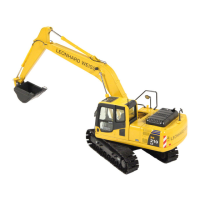
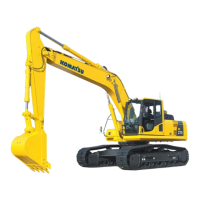
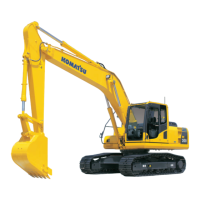

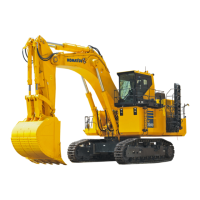
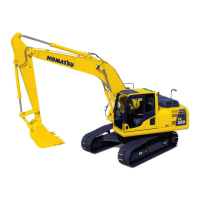

